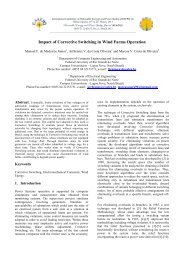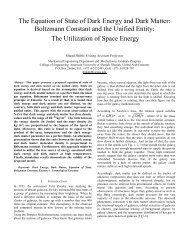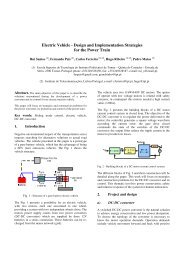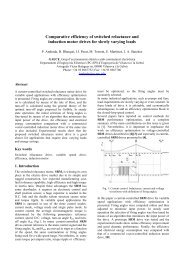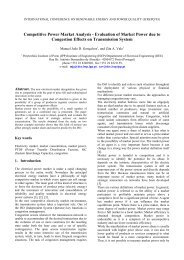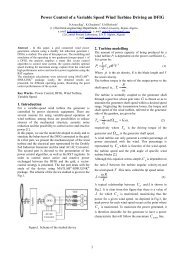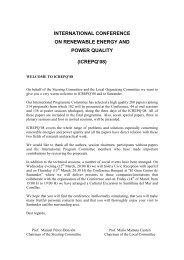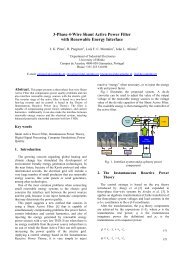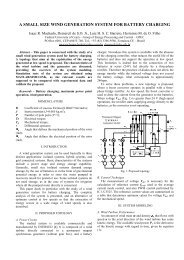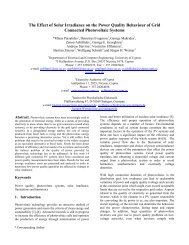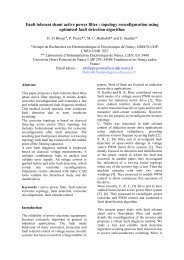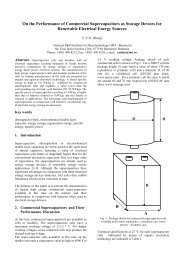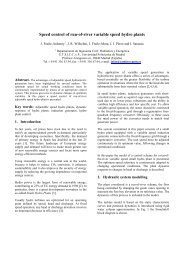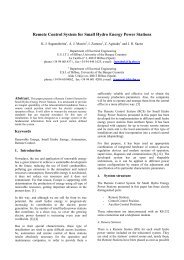Solar photovoltaic water pumping system using a new ... - Icrepq.com
Solar photovoltaic water pumping system using a new ... - Icrepq.com
Solar photovoltaic water pumping system using a new ... - Icrepq.com
Create successful ePaper yourself
Turn your PDF publications into a flip-book with our unique Google optimized e-Paper software.
Fig. 10. Block diagram of the electronic control unit<br />
The PV array current-voltage characteristics, for different<br />
levels of irradiance, are shown in Figure 9. The <strong>com</strong>plete<br />
<strong>system</strong> must be able to work with a threshold irradiance<br />
of 400 W/m 2 ; thus, under these conditions the phase<br />
currents must hold the thrust of the linear actuator. As a<br />
result, the current is regulated, at each instant and at the<br />
reference value, by means of a simple hysteresis<br />
controller that uses just one Hall-effect current sensor.<br />
The output signal of this controller is logically <strong>com</strong>bined<br />
with the output signals of the logical sequencer in order<br />
to generate the <strong>com</strong>mutation signal that turns the power<br />
switches on and off. The direction in which the actuator<br />
moves, which is either up or down, depends on the<br />
sequence of phase excitation that is determined according<br />
to the state of two limit switches, one placed in the<br />
uppermost position and the other in the lowest position<br />
that the mover can reach. The electronic control unit is<br />
fed through a regulated power stage from the PV array<br />
output. A block diagram of the electronic control unit is<br />
shown in Figure 10.<br />
4. Conclusions<br />
A solar PV <strong>water</strong> <strong>pumping</strong> <strong>system</strong> <strong>using</strong> a <strong>new</strong> doublesided<br />
flat two-phase variable-reluctance linear stepper<br />
motor suitable for developing countries was proposed.<br />
The <strong>system</strong> consists of a piston-type <strong>water</strong> pump, a linear<br />
motor mounted onto the piston rod that drives the pump<br />
with the help of a rope, a pulley and a counterweight. The<br />
actuator pump ensemble is controlled by a simple<br />
electronic unit that manages the electric power generated<br />
by a <strong>photovoltaic</strong> array. A <strong>water</strong> reservoir <strong>com</strong>pletes the<br />
installation. The <strong>system</strong> was projected for a specific rural<br />
<strong>com</strong>munity near the town of Asela in the Rift Valley in<br />
Ethiopia. The proposed <strong>system</strong> is suitable for rural<br />
<strong>com</strong>munities in developing countries because it is<br />
reliable, affordable and easy to maintain; in addition,<br />
most of its parts can be manufactured in developing<br />
countries.<br />
References<br />
[1] E. Lorenzo. “Photovoltaic Rural Electrification”.<br />
Progress in Photovoltaics: Research and<br />
Applications. Vol. 5, pp. 3-27, 1997.<br />
[2] J.N. Shretha. “<strong>Solar</strong> PV Pumping System for Rural<br />
Development in Nepal: Problems and Prospects.<br />
1996.<br />
[3] S. Makukatin. “Water from the African Sun”. IEEE<br />
Spectrum, October 1994, pp. 40-43.<br />
[4] T.D. Short, M.A. Muller. “<strong>Solar</strong> Power Water<br />
Pumps: Problems, Pitfalls and Potential”. Power<br />
Electronics, Machines and Drives, IEE Conference,<br />
16-18 April 2002, pp. 280-288.<br />
[5] C. Perris, Z. Salameh. “Photovoltaic-powered pistontype<br />
<strong>water</strong> pump controlled by linear motor”.<br />
Progress in Photovoltaics: Research and<br />
Applications, Vol. 3, 1995, pp. 265-271.<br />
[6] I. Boldea, S.A. Nasar. “Linear Electric Actuators and<br />
Generators”. Cambridge University Press, 1997.<br />
[7] J.Castro. “Bombeig solar amb actuadors de<br />
reluctancia”. PFC-EPSEVG (in catalan), January<br />
2007.<br />
[8] D. Meeker. Finite Element Method Magnetics<br />
(FEMM), Version 4.0 User’s Manual, January 2006.



